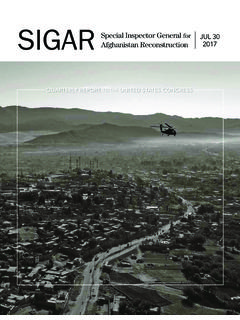Transcription of Transitioning Control of Afghanistan’s Air Space to …
1 Transitioning Control of afghanistan s Air Space to the afghanistan civil aviation authority Executive Summary In late 2001, the military took formal Control of afghanistan s airspace, contracting air-traffic Control positions to international firms. While an eventual transfer of full management responsibilities to the afghanistan civil aviation authority (ACAA) is envisioned, a lack of qualified air-traffic controllers, and widespread corruption mainly in recruitment and contracting aspects, are obstructing this planned transition. The information provided about corruption in this paper is mainly based on the interviews with different ACAA officials as well as some of the important reports including SIGAR s Audit Report (15-58, May 2015). Despite huge amounts spent to turn the ACAA into an independently functioning authority (The US has spent $ million on ACAA-related activities since 2002), it still lacks adequate expertise to independently Control Afghan airspace.
2 Corruption has impeded the transition process principally by: Influence in the recruitment process by high-ranking GIRoA officials, political leaders, and MPs, which results in key ACAA positions filled by incompetent and uncommitted individuals. Abuse of contracting processes, particularly when contracting with outside service providers. MEC has learned that the Contracting Department in ACAA is not conducting the required inquiries on the background of companies participating in bidding. Companies winning the contract through collusion rather than the legal bidding process may not fulfill all their contracting obligations, including building Afghans technical capacities, which is a key to ACAA independent Control of airspace. Of the 12 officials MEC interviewed in ACAA, the majority are of the opinion that a number of ACAA officials are interested to continue contracting external service companies mainly because of the benefit they get from these companies.
3 Thus, they are not interested to initiate reforms, important human resource decisions and create a comprehensive capacity development mechanism to ensure adequate technical expertise for air traffic controllers. However, these claims have not been confirmed by independent sources. While the ACAA has generated about $33 million in annual revenue in recent years 70% of which has come from charging fees to airlines overflying afghanistan the potential exists for the ACAA to generate even more revenue if and when it meets internationally recognized aviation standards and assumes Control over Afghan airspace. Now, its failure to meet these benchmarks means that many countries, including those of the European Union prevent their airlines from landing in afghanistan . This deprives the ACAA of the ability to charge them landing fees, which constitute a major revenue stream for most countries civil aviation authority .
4 However, the dearth of trained air-traffic controllers makes it difficult to estimate when the ACAA will be able to meet international standards and thereby allow more airlines to introduce services to afghanistan . Independent Joint Anti-Corruption Monitoring & Evaluation Committee 2 I. ACAA`s Legal Status ACAA was established as a separate budgetary unit based on Presidential Decree No. 88, dated 1391/08/08 (October 30, 2012). II. Background afghanistan s civil - aviation system plays an important role in the country s economy. However, the previous three decades of instability and civil conflict inflicted huge losses and severely impaired the sector. Amidst the turmoil of war, the Afghan government did not have the infrastructure or the capability to manage its airspace or provide other civil aviation services.
5 The civil aviation Law was also passed in 2012. The ACAA s key responsibilities include regulating and monitoring activities of air-transport providers, representing afghanistan at International civil aviation Organization (ICAO) meetings, developing policies to govern air travel, and managing operations of the nation s has 63 domestic and four international airports (located in Kabul, Kandahar, Herat, and Balkh provinces). afghanistan s civil - aviation system consists of both airspace management and airport services. Airspace management denotes air-traffic Control services, as well as airspace communication and navigation systems. Airport services consist of Control -tower operations, meteorology reporting, and rescue services. Overseeing the civil - aviation system is the primary responsibility of the ACAA. Improving the substandard state of afghanistan s civil - aviation system was among the top priorities of the international community in the post-Taliban era.
6 Beginning in 2002, the Department of Defense (DOD) and Federal aviation authority (FAA) stepped in to help rebuild the system. In total, agencies have spent $ million for civil aviation -related activities in afghanistan since 2002, with DOD funding amounting to $ million (which mainly paid contractors to administer the airspace) and FAA funding amounting to $ In addition, USAID provided the Afghan government with a $ million grant to help rehabilitate two regional airports in 2010. Other Coalition partners and international organizations, among them the German, Japanese, and Portuguese governments, as well as the World Bank (WB), also provided support to building afghanistan s civil - aviation system. (See the Appendix for a comprehensive list of international assistance to Afghan civil aviation .) Delays in Transitioning Control and the end of funding From late 2001 to December 31, 2014, afghanistan airspace management services were provided by foreign governments and militaries (FAA, DOD, and Coalition forces).
7 The had planned the transition of airspace management responsibilities to GIRoA at the end of 2014, but could not since GIRoA was not ready to accept the responsibilities. According to the former head of the Ministry of Transportation and civil aviation , the main reason for delaying the transition was the lack of certified air-traffic controllers, which provided the basis for extending the military contract from January through June 2015. With the expiration of the military s air-traffic Control contract in June, and to avoid any disruptions in air services, the Department of State funded an interim DOD-managed contract for $ million that ran through September 2015. representatives made it clear to their Afghan interlocutors that further extensions or bridge contracts were not in the offing. 1 Report of ACAA s Human Resource Department, July 2015 2 SIGAR, 15-58 Audit Report, May 2015.
8 3 The threat of imminent disruption to air services forced the Afghan government into action. In June 2015, the government signed a $ million two-year contract with RMS after this company won the competition against five other companies (September 2015 through September 2017). RMS will manage Afghan airspace, including the operation and maintenance of equipment, supply of spare parts, and training of selected technical staff. The contract was approved by the new National Procurement authority (NPA). The NPA claimed that this new contract constituted a substantial savings, since the previous $236 million contract was for five years. According to ACAA s officials, the main reason behind the significant decrease in the cost of contract with RMS, as compared to previous ones, is the increased involvement of ACAA 's contracting department in the process of contracting and a decreased number of Afghan professionals to be trained under this contract.
9 However, this is dubious since if the previous contract had worked out as planned, it would have resulted in afghanistan taking Control of its own airspace and there would have been no need to spend almost $50 million on a new contract. Despite the millions invested, the ACAA still lacks qualified air-traffic controllers The ACAA estimates that 55 trained and certified controllers would be required at the Kabul Area Control Center and the Kabul Approach Control facility alone. An additional 84 controllers would be needed to fully staff the Control towers at Kabul, Kandahar, Herat, and Mazar-e-Sharif international airports. Although the FAA provided training for 96 Afghan civil - aviation personnel, the program did not succeed in producing enough air-traffic controllers to operate the civil - aviation system. According to Afghan officials, the majority of FAA-trained Afghan personnel (including air traffic controllers) have not yet completed the required on-the-job training a result, the Air Traffic Controllers are not fully capable to carry out the entire airspace Control functions.
10 Security concerns in the Kabul Area Control Center and Kabul Approach Control facility, which contain information about Coalition military flights and operations, prevented students from accessing these facilities. The FAA also faced problems when trying to send the students abroad for training because many of them could not obtain visas. Furthermore, most of the ACAA s and Coalition s training programs funded only basic academic training in air-traffic Control and were not supplemented with essential on-the-job training. Essentially, the Afghan government s inability to field a sufficient number of trained personnel ended up costing it $ million, not saving $188 According to an ACAA official, the ACAA plans to carry out about 80% of the airspace-management services by the time this contract concludes in late 3 MEC interview with ACAA official, July 2015.


